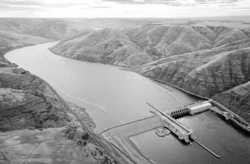forum
library
tutorial
contact

Bush Has Responsibility to Protect Salmon
by Jan HasselmanThe News Tribune, March 13, 2005
|
the film forum library tutorial contact |

|
Bush Has Responsibility to Protect Salmonby Jan HasselmanThe News Tribune, March 13, 2005 |
 The phone-book-sized document has generated considerable controversy since its release a few months ago. Underneath all the technical analysis and legal jargon, the plan embodies a deeply radical change in how the federal government interprets its duty to protect endangered salmon in the Pacific Northwest.
The phone-book-sized document has generated considerable controversy since its release a few months ago. Underneath all the technical analysis and legal jargon, the plan embodies a deeply radical change in how the federal government interprets its duty to protect endangered salmon in the Pacific Northwest.
The administration’s plan is divisive, fiscally irresponsible and, if it stands up in court, might ultimately doom the Columbia’s once-great salmon runs – and the communities that rely on them – to the history books.
The Endangered Species Act requires the government to prepare the plan, which is technically called a “biological opinion” (or “BiOp” for short), because wild salmon and steelhead in the Columbia Basin are threatened with extinction. The BiOp is supposed to analyze how well salmon are doing and how the government should operate its hydroelectric dams without contributing to further declines. In the past, BiOps on the Columbia River have acknowledged that recovering salmon and steelhead is going to take an enormous amount of work and big changes in the way we use the dams. In fact, the last BiOp completed in 2000 acknowledged that the best way to recover Snake River stocks was to remove four dams in the lower part of the Snake River.
A federal judge threw out that plan in 2003. He ruled that the plan was illegal because it relied on speculative habitat improvements to bridge the enormous gap between the species’ needs and the impacts of the dams.
Instead of addressing the judge’s concerns, however, the Bush administration’s latest version of the BiOp radically reinterprets key provisions of the law to arrive at their preferred outcome. In other words, rather than try to get the ball into the end zone, as the law requires, the administration simply moved the end zone toward the ball.
In order to sidestep the requirements of the Endangered Species Act, the administration claimed that the law applies only to actions where a federal agency has virtually unfettered control. It further argued that it lacked such control over nearly all of its actions on the Columbia and Snake, such as power generation, flood control and water withdrawals for irrigation.
In other words, the BiOp concludes that the vast majority of federal agency activities in the Columbia are simply not covered by the law, and can proceed without regard to their impacts. So even though the dams kill up to 90 percent of some salmon stocks, the new BiOp claims that this isn’t their concern any longer.
When a draft of the document was released this fall, jaws fell open in amazement. The Nez Perce Tribe, for example, called the plan an “incredible step backward” that violated the law as well as federal treaties. The Washington Department of Fish and Wildlife called it a “radical departure” that could “destabilize the region politically and economically.”
More than 600 business owners from across the nation, deeply worried about the economic impacts of further salmon declines, wrote a letter to the president blasting the plan and asking him to withdraw it. So did more than 250 top scientists and 102 U.S. representatives from both parties, and 85,000 citizens wrote the agencies and urged them to abandon this irrational new approach. The State of Oregon was so concerned by the Bush plan that it joined the salmon advocates’ lawsuit to have it overturned.
The document is back in front of a federal judge, and he will have to decide whether this approach violates the law. However, for the people of this region, it will take more than a court ruling to ease the sting of the administration’s abandonment of Pacific Northwest salmon runs.
The plan essentially tells the people of this region that the federal government is no longer going to be accountable for its actions, and that if we want salmon in our rivers and streams, we’ll have to figure out how to put them there ourselves.
Instead of dealing with the No. 1 killer of salmon – dams – we might have to restrict property rights, ratchet down even harder on recreational and commercial fishing, and increase our reliance on risky hatchery Band-Aids.
Instead of getting salmon recovered and off the endangered species list, the approach embodied in the BiOp condemns them to a future of permanent listing or even extinction.
Salmon advocates have a vision for an environmentally and economically thriving Snake River Basin. It includes a package of investments in renewable energy, efficient transportation and partial removal of four low-value dams. The Bush administration also has a vision of sorts, one that includes walking away from the problem.
We think that restoring salmon and recovering the communities that rely on them is the better choice.
Related Pages:
Are Dams Here to Stay? by Scott Levy, Idaho Mountain Express, 1/5/5l
Survival of Downstream Migration data from NOAA Fisheries, 12/21/00
learn more on topics covered in the film
see the video
read the script
learn the songs
discussion forum
